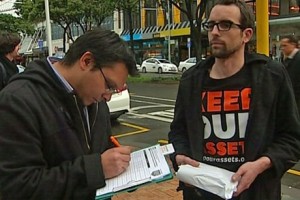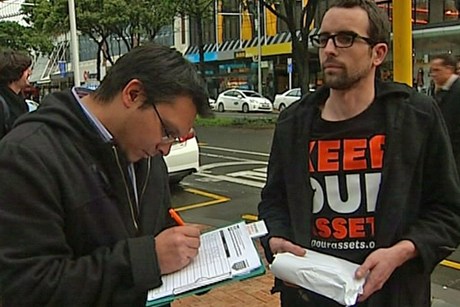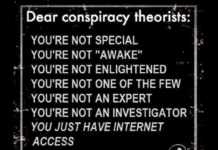 IT WASN’T A CON, but it wasn’t smart, either. The attempt to use the Citizens Initiated Referendum process to halt the Government’s partial privatisation programme was always a risky strategy. Political parties, in particular, take a huge risk in associating their names with operations in which so many things, over which they have no control, can go wrong. And now, of course, they have gone wrong – badly wrong – and at the worst possible moment.
IT WASN’T A CON, but it wasn’t smart, either. The attempt to use the Citizens Initiated Referendum process to halt the Government’s partial privatisation programme was always a risky strategy. Political parties, in particular, take a huge risk in associating their names with operations in which so many things, over which they have no control, can go wrong. And now, of course, they have gone wrong – badly wrong – and at the worst possible moment.
It’s the perception that the “Keep Our Assets” petition has failed, on the very eve of the Government learning how much Mighty River Power’s shares are worth, that’s done the damage.
Political insiders may know that CIRs almost always fall short on the first official count. That someone has only to shift flats, and write their new address on the petition form, for the Clerk of the House to disallow that person’s signature. Unfortunately, 90 percent of the voters don’t know. If John Key tells them that one-in-four of the petition’s signatures are “fake” – they’re quite likely to believe him.
Key can also be reasonably confident that the 40-50 percent of the electorate who back the National Party continue to see the whole “Keep Our Assets” campaign as a politically illegitimate attempt to overturn the result of the 2011 election. On the Right, the conviction that National was given an incontrovertible mandate to sell up to 49 percent of the state-owned energy companies remains unshakeable. To these voters, any backing away from the asset sales programme would be a betrayal. For the Government, reversing the policy has never been an option.
Ironically, the smart strategy for Labour and the Greens was the one they came up with last month – almost by accident.
John Key told the electorate that, if elected to a second term in 2011, National would sell 49 percent of the state-owned energy companies. The voters were thus given the option of backing him or sacking him.
Labour’s and the Greens’ best bet was always to offer voters the same sort of choice. And that’s exactly what NZ Power does. Labour and the Greens have come up with an alternative way of running the energy sector. Working families are being offered the chance to knock $25.00 per month off their power bills. Back it or sack it.
The really silly thing about the “Keep Our Assets” CIR is that a very clear, and cautionary, historical precedent was right there in front of Labour and the Greens.
The Alliance’s (a.k.a Jim Anderton’s) petition for a referendum on the sale of the State’s forestry assets absorbed a huge amount of activist energy in the run-up to the 1996 General Election. Bedraggled Alliance campaign workers, who should have been delivering pamphlets and organising street-corner meetings, were to be found, instead, standing in the rain outside supermarkets trying desperately to collect the required number of signatures before the official cut-off date.
Anderton had studied the Alliance’s 1993 election campaign (when it received 18.3 percent of the popular vote) and decided that its activists’ participation in that year’s big push for MMP had been one of the most important factors in its electoral success. Knowing that an overwhelming majority of New Zealanders were opposed to the sale of state forests, he reasoned that the sight of Alliance candidates and their supporters collecting signatures would, thanks to the new MMP system, deliver an even more impressive tally of votes in 1996.
But it didn’t. The Alliance never managed to collect enough valid signatures to trigger a CIR, and its Party Vote – at 10.1 percent – was well below the party’s 1993 result.
New Zealand voters aren’t silly. They have a fairly shrewd appreciation of what is and isn’t politically possible. They knew back in 1996 that the forests were going to be sold, CIR or no-CIR. And they’re pretty sure the same is true in 2013 – Hell! John Key’s told them often enough. So, when they see people standing outside the supermarket with a clip-board in their hands and a “Keep Our Assets” T-Shirt covering their torso, they don’t think: “Labour/Green/Aged Care/CTU Hero!” Nope, they just shake their heads and mutter: “Nuts!”
It isn’t a reaction conducive to instilling trust and confidence in a Labour-Green alternative government.
Even worse, the Labour-Green failure to collect the required 10 percent of registered voters on the first attempt has provided the National Party’s strategists with some extremely useful intelligence. It tells them that neither of their main opponents possesses anything like the activist base required to pull off such a labour-intensive propaganda exercise.
And the involvement of the CTU was clearly no help. CTU president, Helen Kelly, is always reminding us that, “with 350,000 New Zealand union members in 40 affiliated unions”, the CTU is “the united voice for working people and their families in New Zealand.” Hmmm. If that was true, all she needed to do was ask every one of those union members to sign the “Keep Our Assets” petition and everyone else could have gone home.
What do you think the Minister of Labour, Simon Bridges, is likely to make of the fact that no such mass response was forthcoming from organised labour? Looking at the CTU’s negligible contribution to the “Keep Our Assets” campaign, will the Minister’s reaction be: “Democratic Lion” or “Paper Tiger”?
The extra-parliamentary Left’s demonstrations against asset sales produced a very similar, counter-productive, effect. The first big push, on 28 April 2012, produced a turnout of 6,000-7,000 demonstrators. The second, on 14 July 2012, just 2,000-3,000. The last, on 27 April 2013, attracted barely 500 people in Auckland and a similar number in Wellington. From 7,000 New Zealanders angry enough to join a protest march in April 2012, to less than 1,000 Kiwis just twelve months later. What message do you think those numbers sent to John Key and his colleagues?
Voters really aren’t silly. They know the Government’s partial privatisation programme is a done deal. They’re also reasonably certain that petitions, demonstrations and referendums are not going to undo it. Only a general election can deliver the Government’s opponents the political power necessary to bring a new deal to the table.
If Labour and the Greens would return New Zealand’s energy generators to the hands of the people, they need to put that option in front of them clearly and unequivocally – long before they enter the polling booth.






Correct me if I’m wrong, but you said this months ago on Citizen A! I agreed with you then, and I agree with you now. Why do the left like flogging a dead horse?
It makes me sick every time I see a news item with that “idiot” saying how the Green party has misled the New Zealand Public over this C.I.R, to me it`s the “ultimate” hypocritical statement I`ve heard in a long time.
I agree, is he so stupid as to not realise that we all no he lies and have you noticed how angry he gets when he’s questioned by media on something that’s not going his way
Doing nothing and waiting for Shearer on the basis that Chris Trotter gets excited about one in ten of his statements is far more risky than actually organising people, encouraging activism and having the debate.
Comments are closed.